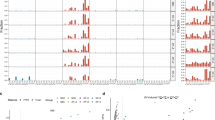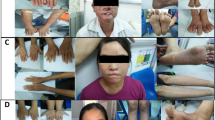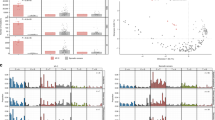Abstract
XERODERM A pigmentosum patients with a defect in the nucleotide-excision repair gene XPA are characterized by, for example, a > 1,000-fold higher risk of developing sunlight-induced skin cancer1–3. Nucleo tide-excision repair (NER) is involved in the removal of a wide spectrum of DNA lesions. The XPA protein functions in a pre-incision step, the recognition of DNA damage4–7. To permit the functional analysis of the XPA gene in vivo, we have generated XPA -deficient mice by gene targeting in embryonic stem cells. The XPA−f− mice appear normal, at least until the age of 13 months. XPA−1− mice are highly susceptible to ultraviolet (UV)-B-induced skin and eye tumours and to 7,12-dimethylbenz-[a]anthracene (DMBA)-induced skin tumours. We conclude that the XPA-deficient mice strongly mimic the phenotype of humans with xeroderma pigmentosum.
This is a preview of subscription content, access via your institution
Access options
Subscribe to this journal
Receive 51 print issues and online access
$199.00 per year
only $3.90 per issue
Buy this article
- Purchase on Springer Link
- Instant access to full article PDF
Prices may be subject to local taxes which are calculated during checkout
Similar content being viewed by others
References
Cleaver, J. E. & Kraemer, K. H. in The Metabolic Basis of Inherited Disease Vol 2 (eds Scriver, C. R., Beaudet, A. L, Sly, W. S. & Valle, D.) 2949–2971 (McGraw-Hill, New York, 1989).
Hoeijmakers, J. H. J. & Bootsma, D. Cancer Cells 2, 311–320 (1990).
Satokata, I., Tanaka, K. & Okada, Y. Hum. Genet. 88, 603–607 (1992).
Sancar, A. Science 266, 1954–1956 (1994).
Grossman, L. & Thiagalingam, S. J. biol. Chem. 268, 16871–16874 (1993).
Robins, P., Jones, C. J., Biggerstaff, M., Lindahl, T. & Wood, R. EMBO J. 10, 3913–3921 (1991).
Guzder, S. N., Sung, P., Prakash, L. & Prakash, S. Proc. natn. Acad. Sci. U.S.A. 90, 5433–5437 (1993).
Tanaka, K. et al. Nature 348, 73–76 (1990).
Maher, V. M. & McCormick, J. J. Pharmac. Ther. 25, 395–408 (1984).
de Gruijl, F. R. & van der Leun, J. C. Cancer Res. 51, 979–984 (1991).
van Oostrom, C. Th.M., de Vries, A., Verbeek, S. J., van Kreijl, C. F. & van Steeg, H. Nucleic Acids Res. 22, 11–14 (1994).
Fort, P. et al. Nucleic Acids Res. 13, 1431–1442 (1985).
Adra, C. N., Boer, P. H. & McBurney, M. W. Gene 60, 65–74 (1987).
Hooper, M., Hardy, K., Handyside, A., Hunter, S. & Monk, M. Nature 326, 292–295 (1987).
te Riele, H., Maandag, E. R., Clarke, A., Hooper, M. & Berns, A. Nature 348, 649–651 (1990).
Bradley, A., Evans, M., Kaufman, M. H. & Robertson, E. Nature 309, 255–258 (1984).
van Vuuren, A. J. et al. EMBO J. 13, 1645–1653 (1994).
Author information
Authors and Affiliations
Rights and permissions
About this article
Cite this article
Vries, A., van Oostrom, C., Hofhuis, F. et al. Increased susceptibility to ultraviolet-B and carcinogens of mice lacking the DNA excision repair gene XPA. Nature 377, 169–173 (1995). https://doi.org/10.1038/377169a0
Issue Date:
DOI: https://doi.org/10.1038/377169a0
This article is cited by
-
An immunomodulating peptide to counteract solar radiation-induced immunosuppression and DNA damage
Scientific Reports (2023)
-
Chemically induced carcinogenesis in rodent models of aging: assessing organismal resilience to genotoxic stressors in geroscience research
GeroScience (2019)
-
The capacity of oocytes for DNA repair
Cellular and Molecular Life Sciences (2018)
-
Current Perspective in the Discovery of Anti-aging Agents from Natural Products
Natural Products and Bioprospecting (2017)
-
Milestones in Photocarcinogenesis
Journal of Investigative Dermatology (2013)
Comments
By submitting a comment you agree to abide by our Terms and Community Guidelines. If you find something abusive or that does not comply with our terms or guidelines please flag it as inappropriate.



